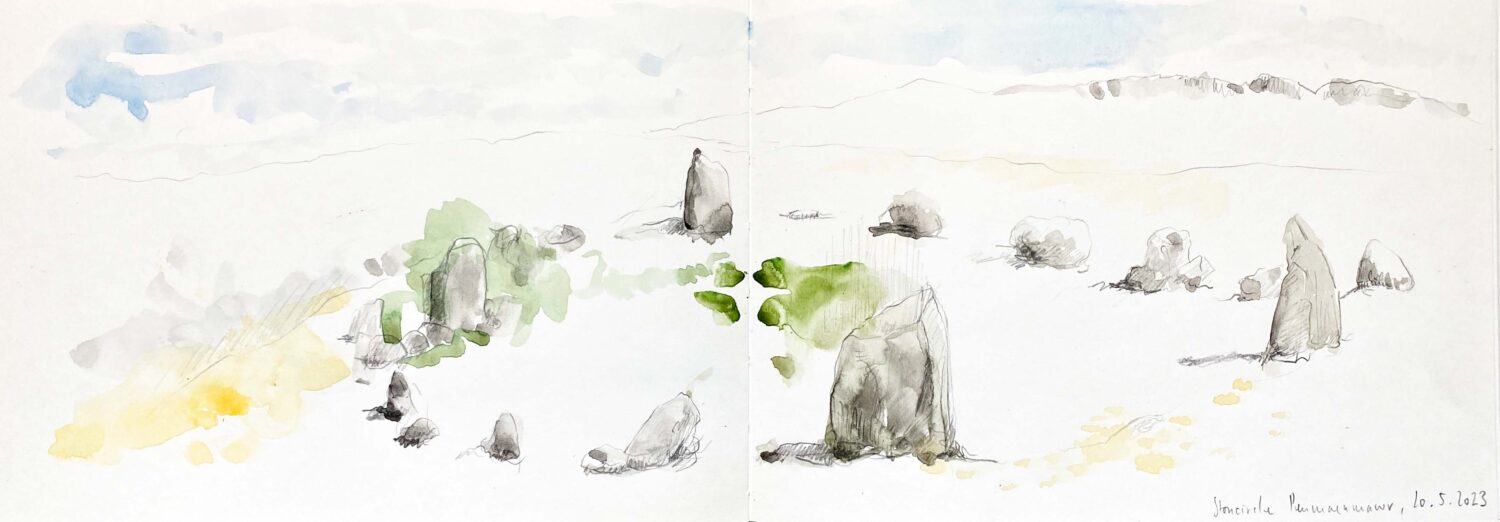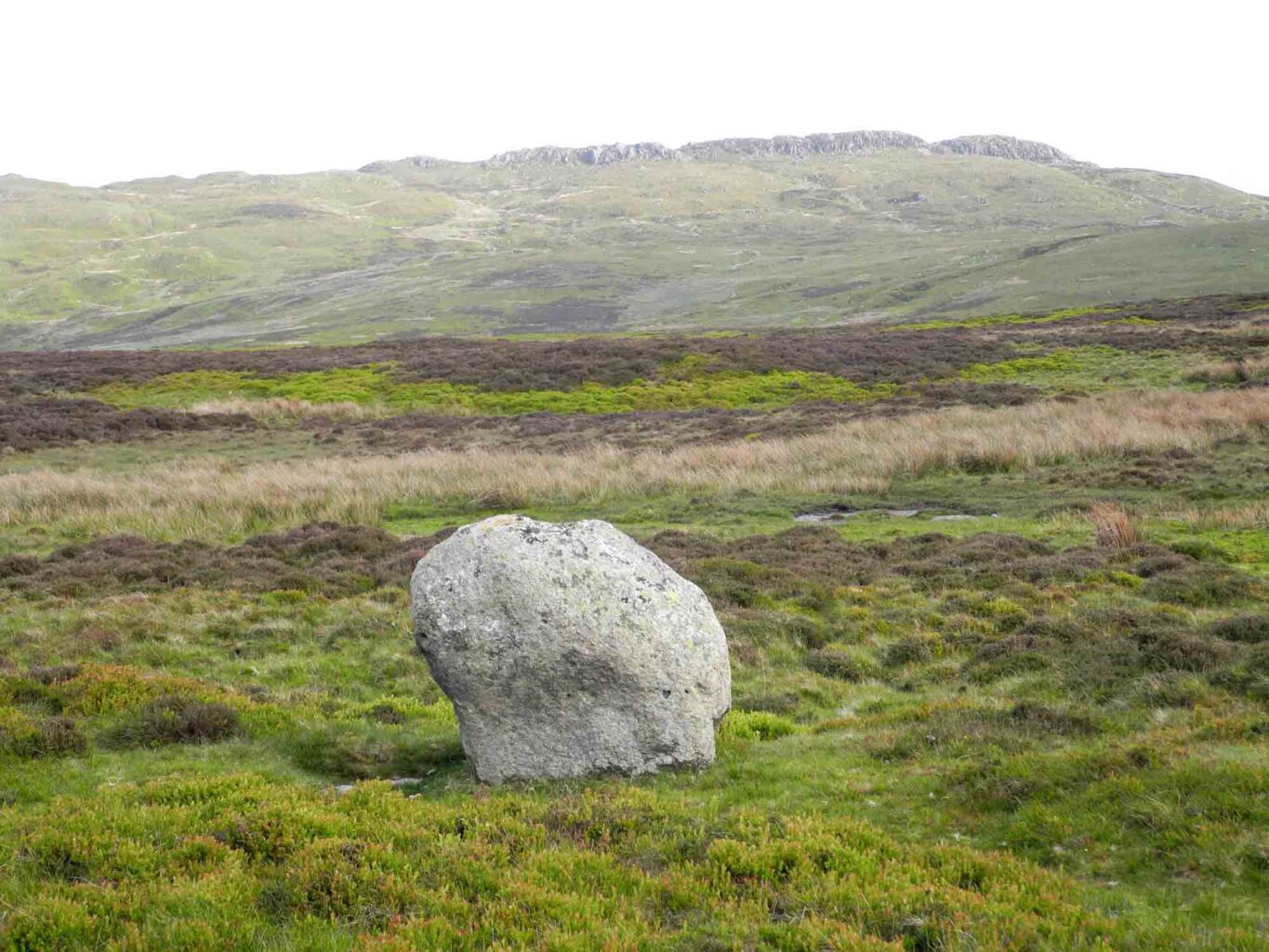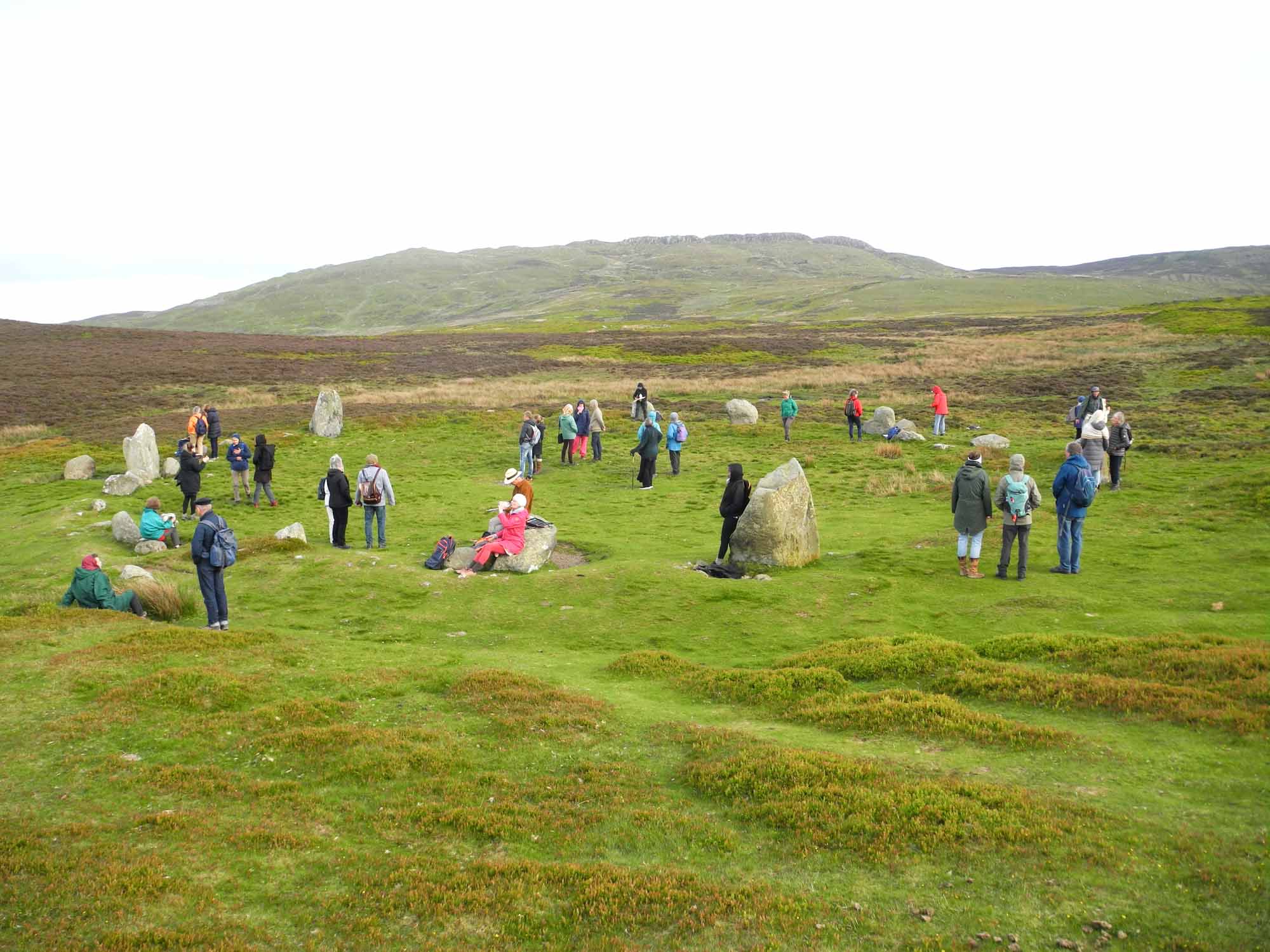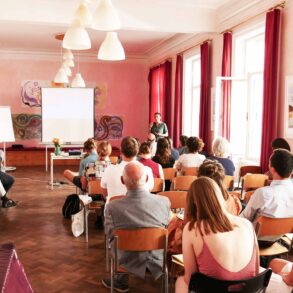One hundred years ago, in August 1923, Rudolf Steiner held the lecture cycle “Initiation Knowledge” in the Welsh coastal town of Penmaenmawr as part of a Summer School organized by Daniel Nicol Dunlop.1 While there, he visited the megalithic stone circles located in the mountains above the conference site. This year, in May, the Visual Art Section held a conference there.
Just before his visits to the stones in Penmaenmawr, Rudolf Steiner spoke about education in Ilkley, not far from the Swastika Stone. Both of these monumental structures, placed into the landscape in Druidic times, made a deep impression on him and seem to have opened up new possibilities for his spiritual perception. He reported more intensively on this journey to England and Wales than almost any other. In the months that followed, the fruits of his experiences shone through in various ways, for example, in the pastel sketch “Druid Stone” (September 1923) and in the four seasonal imaginations (October). These experiences also form an essential part of the background for his decision to renew the Anthroposophical Society with the Christmas Conference of 1923/24 and to develop the Second Goetheanum as a radical metamorphosis of the first building.
While still in Penmaenmawr, Rudolf Steiner wrote to Edith Maryon about “two deteriorated Druid circles”: “There is a wonderful solitude there. I went there on foot with Wachsmuth. It was very meaningful for me to stand by the Druid sanctuaries, where people tended to spiritual matters so many years ago. The way up (about 1¼ hour) was very beautiful, full of the most beautiful views of the surroundings.”2 He drew a “mountain view”—two rounded hills with a valley in between—as well as the outline of a large circle of twelve stones and a small circle of seven stones, each with a point in their centers. The circles were united by an enclosing shape (see image). Guenther Wachsmuth also remembered this visit: “When we arrived at the cliffs high above Penmaenmawr, the lonely circle of the high plateau, surrounded by rocky peaks, now lay before us, and in the middle stood the enormous stone signs of the Druid circle. It was . . . a unique and peculiar picture when Rudolf Steiner then stepped into the middle of the Druid circle in the solitude of this high plateau.”3
During the month of September, Steiner reported three times about his experiences at the two stone circles. On September 30, while in Vienna, he said: “Right upon the very mountain we had climbed, there was a kind of larger solar circle, and, at a short distance away, a smaller one. If one had gone up in a hot-air balloon and looked down upon these two Druidic circles and didn’t take notice of the small distance between them, one would have seen (something quite thrilling!) the same ground plan as the burned-down Goetheanum in Dornach.”4 This experience does not arise from simply observing the site of the stone arrangements. We can, therefore, ask ourselves whether these statements should be understood as indicating only an optical impression.

100 Years Later
Beginning on Ascension Day 2023, the Visual Art Section, in collaboration with the Anthroposophical Society in Great Britain, held a conference called The Inspirations of the Megalithic Culture and the Future Impulse of Anthroposophy. It did not take place in Penmaenmawr (the venue of the 1923 Summer School no longer exists) but in nearby Conwy. The heart of the conference included three excursions to the stone circles. Nearly fifty people from different countries were guided on these treks by Rudolf Kaesbach, who is quite at home in this place. For many years, he was the leader of the Visual Arts Training Course at Emerson College and, along with his students and colleagues, frequently explored the Penmaenmawr stone circles, especially in their relationship to the landscape, discovering many parallels to the positioning of the Goetheanum in its own surroundings.5
Pieter van der Ree also offered contributions on megalithic culture itself as well as on Steiner’s engagement with the topic. Christiane Haid and Renatus Ziegler gave presentations on the lectures Steiner gave at Penmaenmawr. They described how Steiner wove together central themes from the whole spectrum of anthroposophy in a new way, revealing a fully modern initiation knowledge. Integrated throughout the conference were depictions of the ancient initiate science of the Druids as it was practiced in nearby places. Marjatta von Boeschoten spoke impressively about Rudolf Steiner’s time in England. Barbara Schnetzler, who was responsible for the on-site logistics and organization, led the group in singing each morning as well as on a hike to the oldest church in the area (St. Celynnin’s Church, Llangelynnin). Johanna Berger offered drawing and painting sessions. Sunday concluded the conference with a visit to the studio of sculptor David Nash in Blaenau, who has been working with both living and dead wood for decades. Anselm Nicolas Gadacz and Barbara Schnetzler brought a warm and beneficial atmosphere to the conference as a whole, both in their practical organization and an attentive human touch.
Paths and Circles—Time and Space
We approached the stone circles on the plateau of Penmaenmawr (built about 5,000 years ago) along three different paths—first, from the west; then, from the east, both times heading upwards from the depths of the valley; and, lastly, from above, over a small pass in the south. With every step, our perspective of the surroundings changed. Sometimes, we had a mountain or a bowl-shaped depression in front of us like a still image; sometimes, everything became much more dynamic. The mountains appeared staggered, one behind the other, or, at other times, the valley basin filled out the view behind them. Again and again, we came across lone marking stones, like signposts that wanted to draw our attention to something. Finally, standing in the center of the main circle with its twelve sections, we experienced how a separate part of the landscape stood out behind each of the twelve quite different stones; the landscape sections corresponding in a complementary way with the shape of the twelve stones themselves. The outer movement along the paths came to a stillness here. I stood in the center not only of the circle and the landscape surrounding it but also in my own center, where an inner movement began to be stirred by the different perspectives.

The most impressive thing for me was seeing the way down from our position above: my view sweeps over the wide, high basin and the sea behind it. All of a sudden, in the distance, just before the sea, I discover the upright standing stones. In this moment, everything changes: not only does the path obtain a destination, but the entire landscape is given a center out of which the whole atmosphere arises. But just as much as this group of stones blends into the landscape, it unquestionably appears as a human design. Indeed, some of the marking stones seem almost like individual human forms. Is it this place, made 5,000 years ago, that causes this? Is it I who sees it this way today, who perceives it so? Human and world suddenly form a unified whole. To be able to experience and co-create this whole, certain pathways were required today, just as they were in the days of its original creation.
In order to get an overview of the circle from the periphery, I stood on a small elevation. At first, I was disturbed by the people moving around and between the stones; I wanted to have a “pure” view of the stones and capture it in a photograph. So, I waited impatiently until the others went on their way. Suddenly, it “clicked”: the human beings actually belong here! The circle is actually about them, about each individual with his or her unique perspective on the world. Only when we meet in a circle and understand each other’s view of the world can we collaboratively shape our future! The old site provides a stimulus for the present to direct our view to something that wants to come from the future. This brings to mind what Joseph Beuys called a “permanent conference,” which he illustrated by way of a chalkboard drawing of a double chalice saying: “It is an alchemical model that goes back to the crucifixion of Christ, actually, to Joseph of Arimathea. The idea of the Grail is that the blood of Christ is collected and transubstantiated. According to legend, it arrives at the center of King Arthur’s Round Table. Thus, the small Grail within the big is actually the symbol of the individual in society. Arthur’s Round Table becomes extended to a permanent conference. The microcosm becomes the macrocosm.”6
To the west of the large circle of twelve lie two smaller circles. One forms a crescent-shaped space; the other, much more inconspicuous, appears entirely given over to the periphery. In the east, a small circle of only five stones, likely a little younger, forms a kind of entrance gateway into the “sacred” area. Standing in this place, we see the main circle and are practically drawn towards it. First, though, we have to overcome some small ups and downs, during which we lose sight of the main circle and are left to find a new impulse on our own. Physically, this is not difficult, but we definitely experience a drama along this path, one that leads through various stages. In spite of the short distance, there is a sharp focus on the path as such and, thereby, on the movement in time. What was experienced on the longer paths, in terms of transformations in relation to the surroundings, became a dense concentration and invited me to recognize that there was something special here. Then, I stood in the open space of the main circle. Now, in this place, I brought the twelve different relational positions of the people from ages past into a fully conscious and real experience. These perspectives enabled me to perceive different qualities, all of which corresponded to an inner experience. As Rudolf Kaesbach had discovered, the forces of the zodiac begin to speak in this twelveness. Thea Kaesbach showed the eurythmy gestures of the twelve zodiac signs in front of the corresponding stones, each with their unique scenic backgrounds, and thereby provided us with an intensive conjoined experience of landscape and gesture. The different perspectives on the world—the twelve world views—coalesced, and only together did they form something akin to reality.
It was astounding to find something here from the distant past that carries within itself the seed for a new kind of community building, experienced in the middle of nature, enhanced by a human-built monument. A thoroughly Pentecostal event!

From the First to the Second Goetheanum
With these experiences in the background, we can more easily understand Rudolf Steiner’s imagination of the stone circles of Penmaenmawr seen from a birds-eye view as the parallel to the Goetheanum building’s two cupolas. The large cupola—with its two times seven columns—represents the path of development of a human being who receives spiritual revelations. The small cupola—with its two times six columns, its two times twelve forms in the architrave, and the wooden sculpture of the Representative of Humanity—forms the space out of which these revelations can be given. “This Goetheanum has become a double-domed building—a building that is composed of a larger and a smaller cupola—in order to show that something is to be revealed to the present culture and that something is to be received. That which arises from the depths of spiritual life is represented by the small cupola, and the fact of receiving what arises is represented by the large cupola. And I think that destiny has done it well, that whoever approaches this Dornach Hill can already have a kind of inner sensation by the way this double-domed building rises above the Dornach Hill. They can sense that something new is to be placed into the development of humankind, something which at the same time can have an effect on this development.”7
Here at Penmaenmawr, we have the large circle of twelve and the paths to approach it. The highest one, coming from the east and beginning in the coastal town (the path Rudolf Steiner would have taken), initially meets a pentagram of five stones, where we can experience uprightness and, at the same time, we can receive a new view towards a specific goal.8 Then the concentrated archetype of a path begins that leads (as Rudolf Kaesbach observed) through seven steps up to the center of the large circle. We must walk this path individually, while the goal to be reached is the experience and formation of a community. In the First Goetheanum, the community gathered in the Great Hall, like in a forecourt, to receive from there the inspired revelations of individual personalities. Accordingly, the building closed itself off from its surroundings and was completely directed toward what was happening within. Looking back, Rudolf Steiner remarked that the first building had corresponded artistically to the development of anthroposophy only up until 1918.9 Along with the construction of the building itself, he designed the surrounding terrain, including a special path leading up to the building.
The Second Goetheanum building, designed after his experiences in England and Wales in 1923, is much more clearly related to the surrounding landscape than the First Goetheanum. It takes up the stream of movement leading down from the Gempen outcrop in the southeast, transforms it, and gives it a completely new sculptural expression in the west-facing façade, directed towards the cultural world at its feet—both revealing and receiving at the same time. The path of approach now leads toward a meeting with this “countenance.” Now, we are no longer concerned only with the inner development of the individual in the community; rather, we must move on to action in the world, to interaction with our surroundings. Joseph Beuys said, “The Mysteries take place at the central train station, not at the Goetheanum.”10 We can understand this as a continuation of the new impulse given by Rudolf Steiner through the building of the Second Goetheanum.
Translation Joshua Kelberman
Title image Stones and humans in a circle, Photo: Stephan Stockmar
Footnotes
- Rudolf Steiner, The Evolution of Consciousness, CW 227 (SteinerBooks, 2006).
- Letter from Aug. 30, 2023 in Rudolf Steiner and Edith Maryon, Briefwechsel (Correspondence) 1912–1924, GA 263/1 (Dornach, 1990).
- Guenther Wachsmuth, The Life and Work of Rudolf Steiner (Garber Communication, 1995).
- Rudolf Steiner, Michaelmas and the Soul-Forces of Man, CW 223 (SteinerBooks, 1982), lecture in Vienna on Sept. 20, 1923.
- See Rudolf Kaesbach and Stephan Stockmar, “Der Bau und die Landschaft im Gespräch” (The building and the landscape in conversation) in Marianne Schubert and Stephan Stockmar, Man schaue was geschieht: Rudolf Steiner als Landschaftsarchitekt am Goetheanum (One sees what happens: Rudolf Steiner as landscape architect at the Goetheanum) (Dornach, 2022).
- Joseph Beuys in conversation with Antje von Graevenitz in 1982, about a panel drawing done by him in 1977. “Document 6” in Antje von Graevenitz, “Erlösungskunst oder Befreiungspolitik: Wagner und Beuys” (Redemptive art or liberation politics: Wagner and Beuys) in Gabriele Förg, ed., Unser Wagner (Our Wagner): Joseph Beuys, Heiner Müller, Karlheinz Stockhausen, Hans Jürgen Syberberg. Essays. (Fischer-Taschenbuch, 1984).
- Rudolf Steiner, Architecture, Sculpture, and Painting of the First Goetheanum, CW 288 (SteinerBooks, 2017), lecture in Dornach on April 4, 1920; see also Stephan Stockmar, “Die Doppelkuppel des ersten Goetheanum: Ein Arbeitsprinzip des Geisteslebens wird anschaubar” (The double cupola of the First Goetheanum: A working principle of spiritual life becomes visible) in Die Drei, no. 1 (2021).
- Frank Teichmann sees the crescent-shaped circle located to the east of the large circle of twelve as the small circle described by Rudolf Steiner; see Frank Teichmann, The Origins of the Anthroposophical Society in the Light of the Ancient Mysteries (Temple Lodge, 2020). He does not mention the two other circles in this context.
- Rudolf Steiner, “Das Goetheanum in seinen zehn Jahren” (The Goetheanum in its ten years) in Rudolf Steiner, Der Goetheanumgedanke inmitten der Kulturkrisis der Gegenwart (The Goetheanum thought in the midst of the contemporary cultural crisis), GA 36 (Dornach, 1961).
- Interview with Peter Brügge in Der Spiegel, no. 23 (June 6, 1984).













